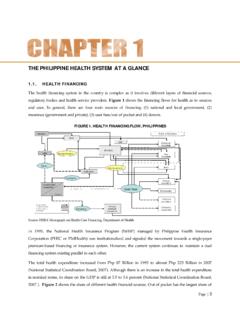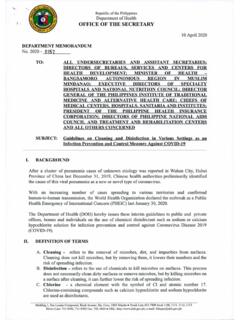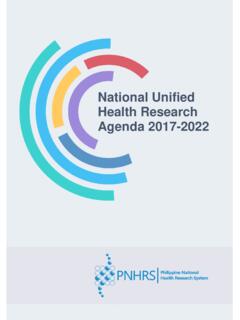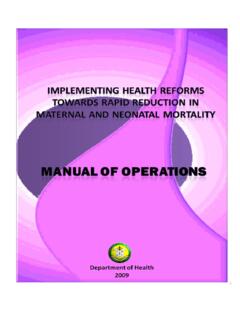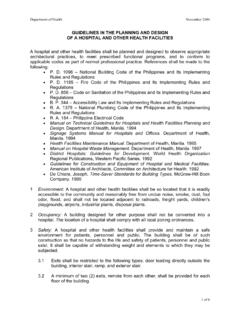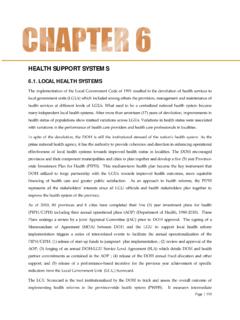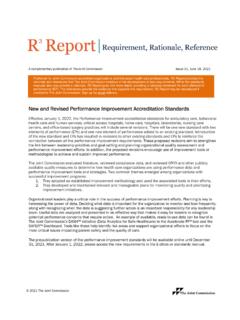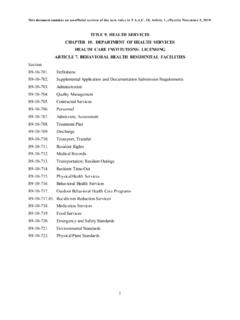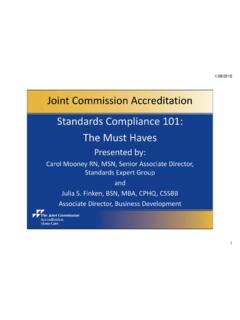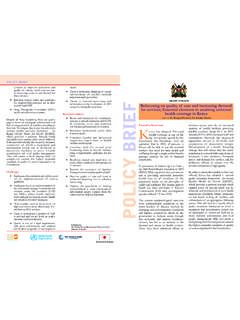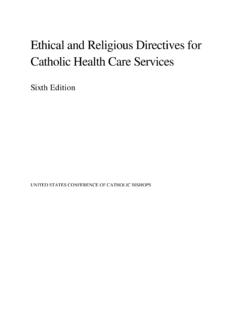Transcription of IMPROVING ACCESS TO QUALITY HOSPITALS AND …
1 Page | 26 IMPROVING ACCESS TO QUALITY HOSPITALS AND health services health FACILITIES The Local Government Code of 1991 resulted in the devolution of health services to local government units (LGUs) that included among others the provision, management and maintenance of government health facilities (district HOSPITALS , provincial HOSPITALS , RHUs, BHS) at different levels of LGUs. Though most of health facilities are devolved, 70 HOSPITALS scattered all over the country are retained by the central government (DOH retained HOSPITALS ).
2 Private sector plays a crucial role in the Philippine hospital system. As noted in the earlier chapter, they account for more than 50 percent of the total number of HOSPITALS . Almost half of the population goes to private facilities for their health care needs. However, private HOSPITALS cater more to the upper socio-economic quintiles and those covered by health insurance. In 2009, the country licensed a total of 721 public and 1,075 private HOSPITALS . In 2010, the total hospital beds are 98,155 (Department of health , 2009). Of these, around half (50 percent or 49,372 beds) are in government HOSPITALS (National Statistics Office, 2010).
3 To ensure provision of QUALITY services , 10,530 facilities have been accredited (n=1835) and issued with licenses (n= 8,695) to start their operations in 2008 (Philippine health Insurance Corporation, Various years). Issuing documents and accreditation are vital processes in QUALITY assurance and monitoring compliance to standards. RHUs and BHS act as providers of public health services at the municipal and barangay levels. From 1996 to 2005, the number of RHUs was declining, and the number of BHS was stagnating. Thus, the number of government primary care facilities cannot cope up with the increasing population.
4 Data has shown that the poorest of the population are the main users of government health facilities, yet these health facilities have suffered neglect due to the inadequacy of health budgets. Lower levels of care were bypassed even for simple primary cases because of deteriorating QUALITY , Page | 27 Source: Department of health lack of human resources, medical equipment and medicines (Department of health , 2010). This is particularly disadvantageous to the poor who need the services the most. KP shall reform the health care delivery systems by focusing on health facility enhancement and rationalization and development of integrated health service delivery network.
5 A functional and complementary network between the different components of local health systems should be formulated and implemented to properly maximize the health resources of each health facility. The DOH budget shall allocate resources in health facility upgrading coupled with IMPROVING the systems for health facility operation and management. health facility enhancement increase hospital revenue from NHIP benefits and other medical and non-medical revenue and sustain the health facilities in providing QUALITY services especially to the poor.
6 NATIONAL OBJECTIVES FOR 2011-2016 OVERALL GOAL: Improved ACCESS to QUALITY HOSPITALS and health facilities by all Filipinos, especially the poor Strategic Objective Indicator Data Source Latest Baseline 2016 Targets ACCESS to QUALITY health facilities and services , especially those commonly used by the poor is improved % DOH retained HOSPITALS upgraded/rehabilitated/constructed DOH Report 10 (Upgraded 2010) 95 % Provincial HOSPITALS upgraded/rehabilitated/constructed DOH Report 25 (Upgraded 2010) 95 % District HOSPITALS upgraded/rehabilitated/constructed DOH Report 30 (Upgraded 2010)
7 95 % RHUs upgraded/rehabilitated/constructed DOH Report 30 (Upgraded 2010) 100 QUALITY of inpatient and outpatient care is improved % DOH-retained HOSPITALS with Center of QUALITY or Excellence accreditation status or equivalent PhilHealth Report 17 (May 2011) 100 Year Number of RHU Number of BHS 1996 2856 1709 1997 2405 13096 1998 1791 14267 1999 2121 14416 2000 2218 15204 2001 1773 15107 2002 1974 15283 2003 2257 14490 2004 2258 15099 2005 2374 15436 TABLE 12. NUMBER OF RHU AND BHS, PHILIPPINES, 2005 ACCESS TO QUALITY HOSPITALS AND health services Page | 28 Number of provinces and large cities with at least one LGU-managed hospital with Center of QUALITY accreditation PhilHealth Report 10 (2010) 70 % RHU/CHO with PhilHealth accreditation PhilHealth Report 59 (2010) 80 % Government HOSPITALS with PhilHealth accreditation PhilHealth Report 88 (2010) 95 % DOH licensed private hospital with PhilHealth accreditation PhilHealth Report 91 (2010)
8 93 Availability of essential drugs and medicines in all levels of government health facilities is ensured % Availability of essential drugs in health facilities at all levels according to the National Drug Formulary Special Facility Survey (2010) 80 ACCESS to specialized services in sub-national health facilities is enhanced No. of Subnational Facilities with specialized services for heart, lung and kidney DOH Report 3 (Upgraded/established in 2010) 5 No. of regional blood centers DOH Report 3 (Upgraded/established in 2010) 9 No. of Cancer centers DOH Report 1 (Upgraded/established in 2010) 3 Governance, sustainability and fiscal autonomy of government HOSPITALS are improved Number of DOH hospital transformed into corporate hospital DOH Report 4 (2010) 6 Number of LGU HOSPITALS with fiscal autonomy or with scheme for economic enterprise DOH Report 1 (2010) 16 Client responsiveness of health facilities is improved % Client Satisfaction Rate Special Survey (2010)
9 90 STRATEGIES FOR 2011-2016 A targeted health facility enhancement program that shall leverage funds for improved facility capacity to adequately manage the most common causes of mortality and morbidity, including trauma; Provision of financial mechanisms drawing from public-private partnerships to support the immediate repair, rehabilitation and construction of selected priority health facilities; Fiscal autonomy and income retention schemes for government HOSPITALS and health facilities; Unified and streamlined DOH licensure and PhilHealth accreditation for HOSPITALS and health facilities; and Regional clustering and referral networks of health facilities based on their catchment areas to address the current fragmentation of health services in some regions.
10 Page | 29 PHARMACEUTICALS The purpose of the regulation of essential medicines is to ensure that no Filipino dies due to problems related to medicines. According to the World Medicines Situation, only 66% of the world population has ACCESS to essential medicines (World health Organization, 2004). Lack of ACCESS to medicines as well as other problems like poor QUALITY and irrational use, has impeded the achievement of the desired health status of the population. ACCESS to or effective availability of essential medicines is influenced by the kind, price, and location of certain drugs, and also by the financing, payment, and organization of systemic actors who define what is offered and at what terms (Roberts, 2004).
